
I’m tired of clients, prospects, CEOs, VPs telling me – we like your cute little content ideas – but “that content doesn’t convert”.
So I wanted to create a post I can not only share with YOU that there is real ROI in content marketing and search. But also, so I have something I can send off to everyone who tells me from now on “content has no ROI”.
In the past 5-7 years of doing SEO consulting full time, I’ve amassed quite a collection of case studies, stories, metrics, and results that search content does drive ROI.
So in the first half of this post, I want to share some of those results with you (some of which I’ve never shared before).
Then in part two, I’ll share a bit about how I drove this traffic with SEO.
Part One: Why “Content Doesn’t Convert” Is Tragically Shortsighted
I truly don’t think the problem lies in whether ‘it converts’ or not. The problem is some channels are easier to measure than others.
But top of funnel content does have ROI. LOTS of it.
Just because it’s not the first, default thing you see in GA, doesn’t mean it’s not happening.
Let’s begin with the most abstract proof first (albeit, still measurable) and work down to the most concrete conversions (actual leads and revenue).
Starting with everyone’s most loved and simultaneously hated topic: SEO.
Top Of Funnel Content Helps Product/Service Page SEO
1. Content Boosts Rankings
Here’s the punchline: highly trafficked, topically relevant informational content boosts rankings of related product and service pages.
At least, I think most of the time.
In other words – it’s what ‘link building’ can do to your rankings, but with content instead.
Publishing top of funnel content that:
- Ranks and gets clicks for related keywords topically (ie: you sell ‘shoes’ and you publish an article ‘how to clean leather shoes’)
- The traffic it receives from search is high quality – ie: users love the content, come back often, share your content, leave comments. It’s not complicated: they like it.
- Some other signals – like you cross link to/from the article and the product/service.
Here are two examples I’ve seen of this in action:
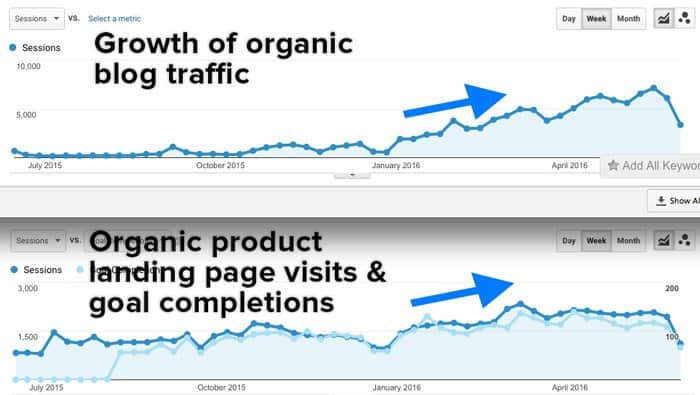
The above shows stats for a SaaS company.
You can see, as their blog (top of funnel) traffic rises, so does their traffic and goal completions for product pages. Not in the same exact proportions, but there is definitely a lift.
No “link building” was done during this time. The only change to SEO was publishing keyword targeted content.
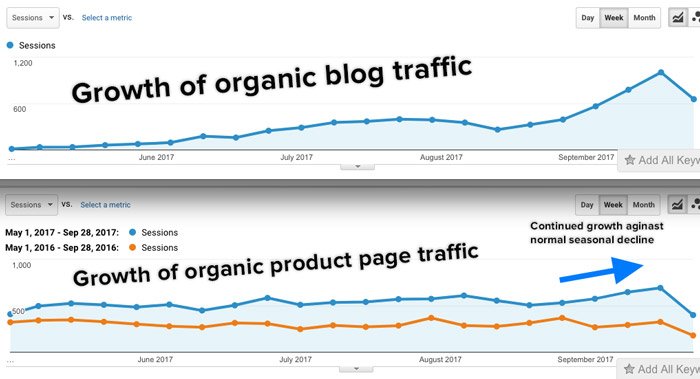
The above, and second example, is a company that sells a high-end product. Even a tiny increase in traffic to product pages is huge for them.
It might not seem like much, but again, that lift in September (against what is normally a down season) is significant.
We did no link building but we did publish topically relevant content that ranks, gets clicks, and users like.
2. Content Creates Context
…and that context is search personalization.
I believe search is becoming more and more personalized, and this personalization is becoming so much more nuanced, so subtle, so…. machine learning and AI.
☝ Tweet this ☝
We hardly notice it. And that’s the way it should be. Creating a fluid, seamless experience in which, as users, we’re just more satisfied.
Yet beneath it… well, here’s a few examples:
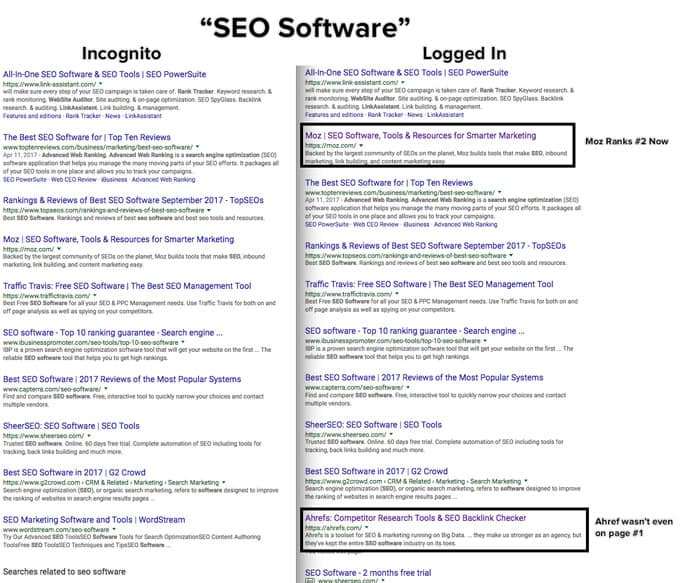
Above:
- Because I’ve visited Moz.com in the past, it means the difference between positions #2 and #4 for “SEO software”.
- Because I’ve visited ahref.com, it means being on the first page when otherwise they are invisible.
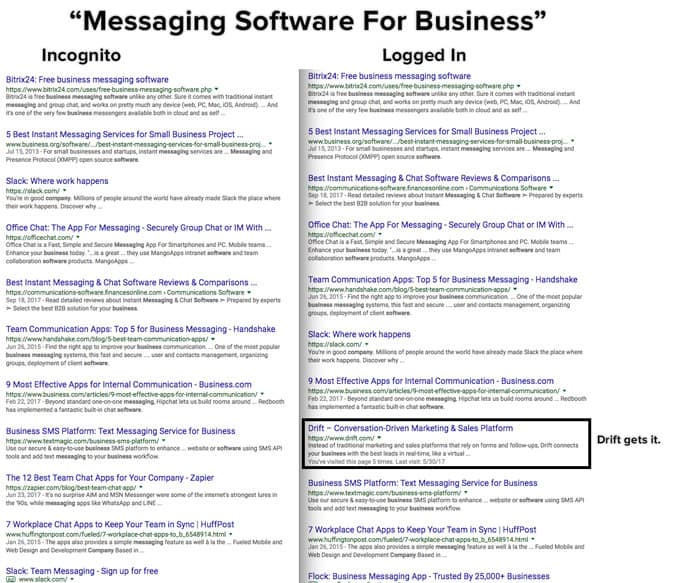
Drift gets it 🙂
- Incognito? Not even on page one for “messaging software for business”.
- In my traffic history? Position #8 on the first page.
3. Content (Sometimes) Puts Link Acquisition On Autopilot

The above stats are links for one piece of content in which we did no pro-active link building for that client.
That’s because it ranks for what I can “intent to link queries”. Meaning, the user is searching Google looking for a reference to link to.
I talked about finding these topics in depth on a webinar with BuzzStream, in which they turned into this post.
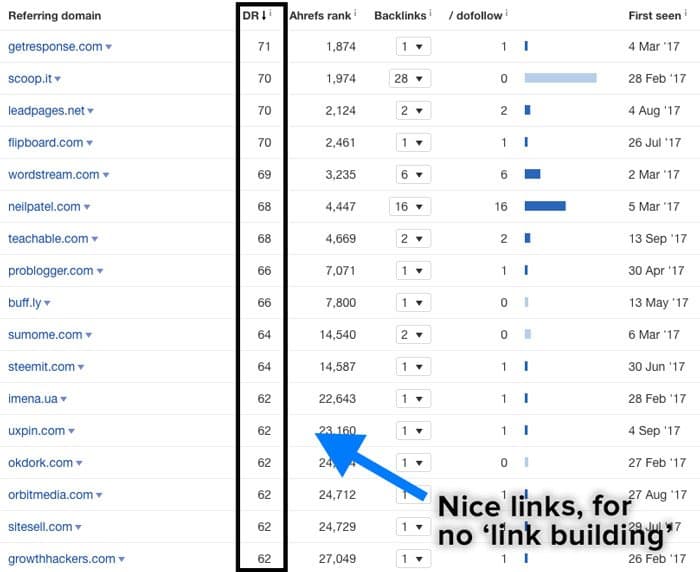
The above shows the actual linking domains for that same piece of content. Those are some pretty decent links! Again, by letting people who need something to reference come to you.
That one article “didn’t convert” but let’s talk numbers (money!) for a moment.
Ross Hudgens from Siege Media recently shared how they calculate the ‘cost of a link’.
Spoiler?
It can cost anywhere from about $150-1000+ per link – this cost is for creating the content and doing the pitching and outreach.
That means the article above? With 50+ linking root domains? Should have cost a conservative $7,500 to create the content and run the outreach campaign. I can assure you, it did not cost that amount. Not even close.
Intelligence
4. It Builds Keyword Lists For You
Proper keyword research takes a lot of time. And sometimes even the best miss opportunities.
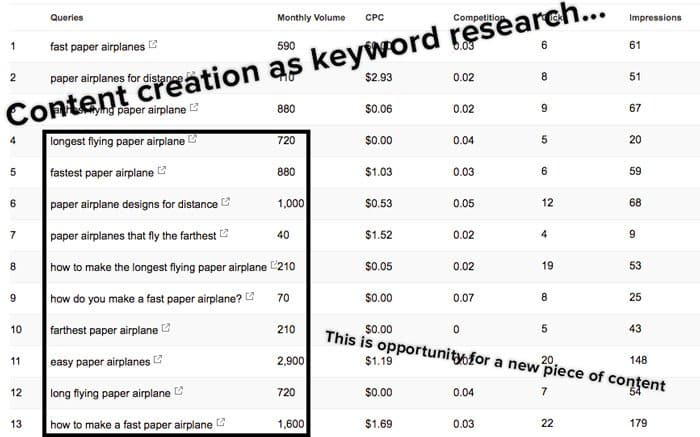
The above is an article about ‘making paper airplanes’. But not the fastest paper airplanes. Which (and it sounds silly) is actually distinct and popular enough to be a totally separate piece of content. One of which my client here does not have. But should. In fact, I’ll go email them right now.
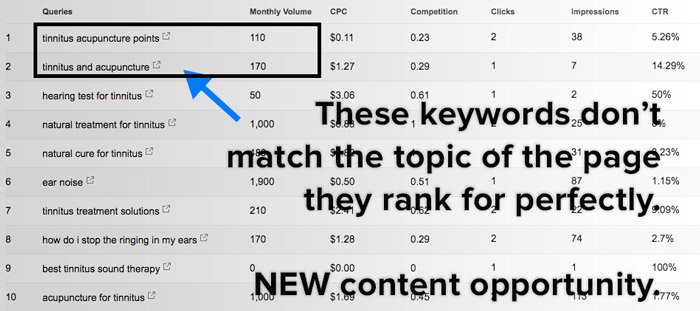
Above, another example. You get the idea.
Publish content, and let the data gather and work for you.
5. Accelerate Growth Of Your Retargeting Lists
Yeah yeah… “content doesn’t convert”.
But guess what converts like mad?

Traffic from Facebook retargeting ads (those 11 conversions for the site above are a huge deal by the way).
But what do you need to run those?
An audience.
How do you grow your retargeting audience, especially if your small or just starting out?
You could buy that traffic – but hmmm… what’s a “free”, ongoing source of quality, relevant traffic?
I wanted to be sure this wasn’t just a theory of mine – so I asked my Facebook ad contractor of 3+ years. He said (paraphrased):
“I noticed a huge jump in the remarketing audience available via the Facebook Pixel in the last month. The blog is bringing in a different set of fresh prospects that aren’t being reached by the paid ads, which has increased the overall remarketing audience significantly.
In the past few months, the remarketing audience size has grown at an accelerated pace. This is a really rough, back of the envelope calculation but…we were only increasing the remarketing audience size by maybe 15%-20% each month at best for a few months, now it looks like more than a 30% increase last month.”
It’s important to note, that for the client referred to above, they have seen strong growth in blog traffic in the past few months, but most significantly in the last month. This matches the pace of growing their retargeting audience.
How It Actually Helps Conversions
I’ve spent a huge amount of time in this post showing how content boosts the performance of converting content and channels.
BUT, content does convert. You might just not be measuring it correctly.
6. It Builds Your Email Lists & Subscriptions
I’m including “goal completions” like email signups, subscriptions and contact form completions in my definition of “conversions” here.
For some sites (like Backlinko) the email signup is the ultimate conversion on-site. And for others, growing your email list essentially translates into revenue because of how strong email converts.

The example above is my own. I care a TON about growing podcast subscribers because I monetize (granted, it’s a small amount for now) my podcast with sponsors.
The more subscribers = the more downloads = the more sponsor revenue.
My point with the above? How in the world would I attribute that with analytics??
I probably can’t.
But (and some are going to hate this next point) … if it happened once it’s probably happened a lot. I only know about it because this guy told me.
But OK… let me give you something we can prove at scale.
It’s called “assisted conversions” and I am shocked at how few people actually look at these. Still. In 2017.
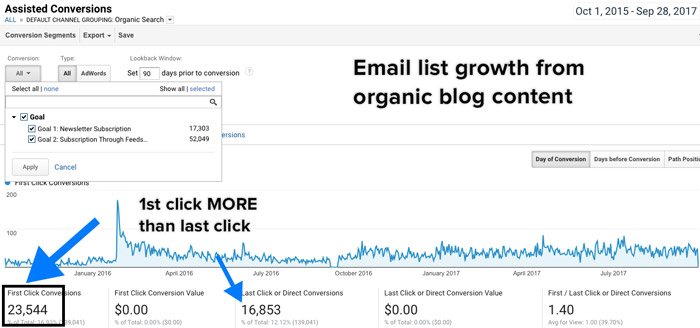
The above shows a client (in the health space) driving MORE (like 7,000 more) email and newsletter signups via organic content on the first click…. more than ‘last click’.
And the number of businesses that fail to look at the first click attribution floors me.
7. Content Converts… If You Look At Assisted Conversions

The above is from an eCommerce company we worked with in 2016. The above revenue is from one piece of content created. Nothing fancy. A simple (but high quality) blog post.
I can hear the CEO, CFO or VP of Marketing now: “It’s great content … but it didn’t covert”. (And you get that sinking feeling in your stomach. You know what I’m talking about.)
Right… but let’s add in how that content helped nurture the path to purchase. Looks like 146 assists is nothing to sneeze at … especially considering this was a simple post.

And finally… real ROI. First clicks turning into revenue.
The above screenshot is from the same eCommerce company. This is first click revenue to one blog post in a two-month period.
Which brings up another aspect of measuring content ROI we still fail at.
You have to masure the ROI of organic content in 12-24+ months periods. Why? Because it can rank, drive traffic and drive revenue for 1-2+ years … with minimal maintenance.
That’s $4,200-8,400 in revenue to this one piece of content.
I think lots of us would make decisions differently … or be more persuasive in our arguments for content … if we actually showed the true ROI of content in this way.
8. Content = Revenue
Now I realize this does not apply to all types of business. Turning a blog post into straight revenue works well in highly personalized, service-based, trust-based situations. Instances in which referrals are a great lead source (think consulting, marketing services etc).
Which makes sense that I have an example below which collectively translated into (the mid) five figures of revenue for me in the last year:
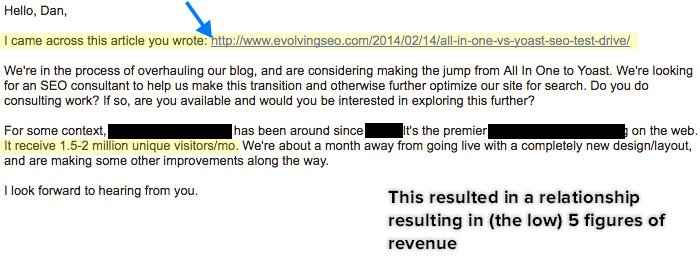
Similar to other examples – I NEVER would have attributed this client to a blog post – except that they told me.
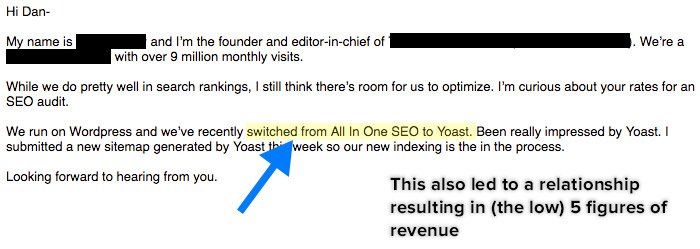
And almost the same exact situation. They found me through the same blog post, and told me about it.
Practicality
Before I close by revealing a few tips for finding these content opportunities. I want to point out two strategic reasons top of funnel content can be a great approach.
9. You’re Probably Creating Content Anyway
Most businesses are already putting resources towards content creation – and getting NO ROI. Yet most businesses could be getting ROI if they just simply wrote about topics likely to drive search traffic.
☝Tweet this ☝
It sounds like I’m overly simplifying – but am I?
You could get ROI by simple choosing topics likely to get search traffic.
I’ll show you a bit about how to do that below.
10. It’s Easier To Win
And guess what – where there’s often push-back, therein lies the potential. In many niches, fewer people are competing at the ‘top of the funnel’ because they don’t think it works.
The same reason this post exists is also why this approach holds opportunity.
Part Two: Crash Course In Finding & Creating Rankworthy Content
While I’ve written, talked and presented at length about my process for finding, creating and maintaining content that ranks – in fact, this video is basically the process below
But here I want to spell out a straightforward process anyone starting out can immediately utilize.
1. Find ‘Seed’ Topics
One of the hardest parts about keyword research and content ideation is coming up with those ‘unknown unknown’ topics. You sell shoes – but what should you write about?
I like generating long lists of starting topics – seed topics – to then dig into the longtails.
Fortunately, there are two tools that are phenomenal at this:
- Moz Keyword Explorer
- BuzzSumo’s Question Analyzer (formerly Bloomberry)
Taking our ‘shoes’ example – let’s say I enter ‘footwear’ into Moz Keyword Explorer.
You’ll first want to set it to find ‘based upon broadly related topics and synonyms’
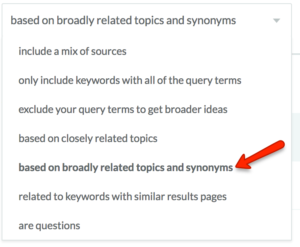
Then for ‘footwear’ you get this:

Perfect! Stuff I may not have easily just brainstormed like “casual wear”, “outdoor clothing” etc.
Remember – these are topics related to ‘shoes’ in which you may find content opportunities.
Even if I just think of “walking” as a starter seed topic, Moz’s tool gets us many more seed ideas:
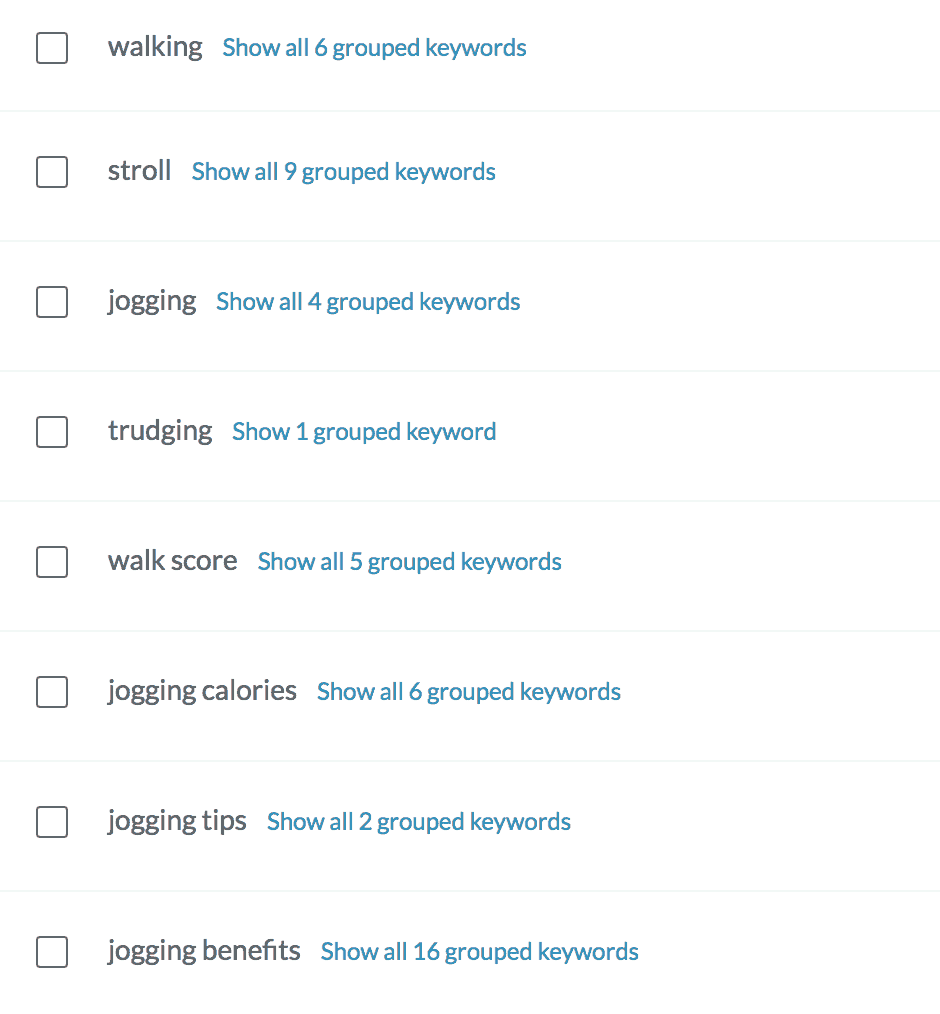
Here’s what you get with BuzzSumo’s Question Analyzer for ‘footwear”:
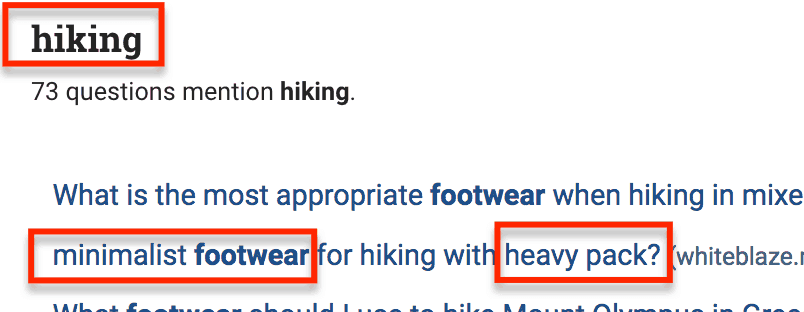
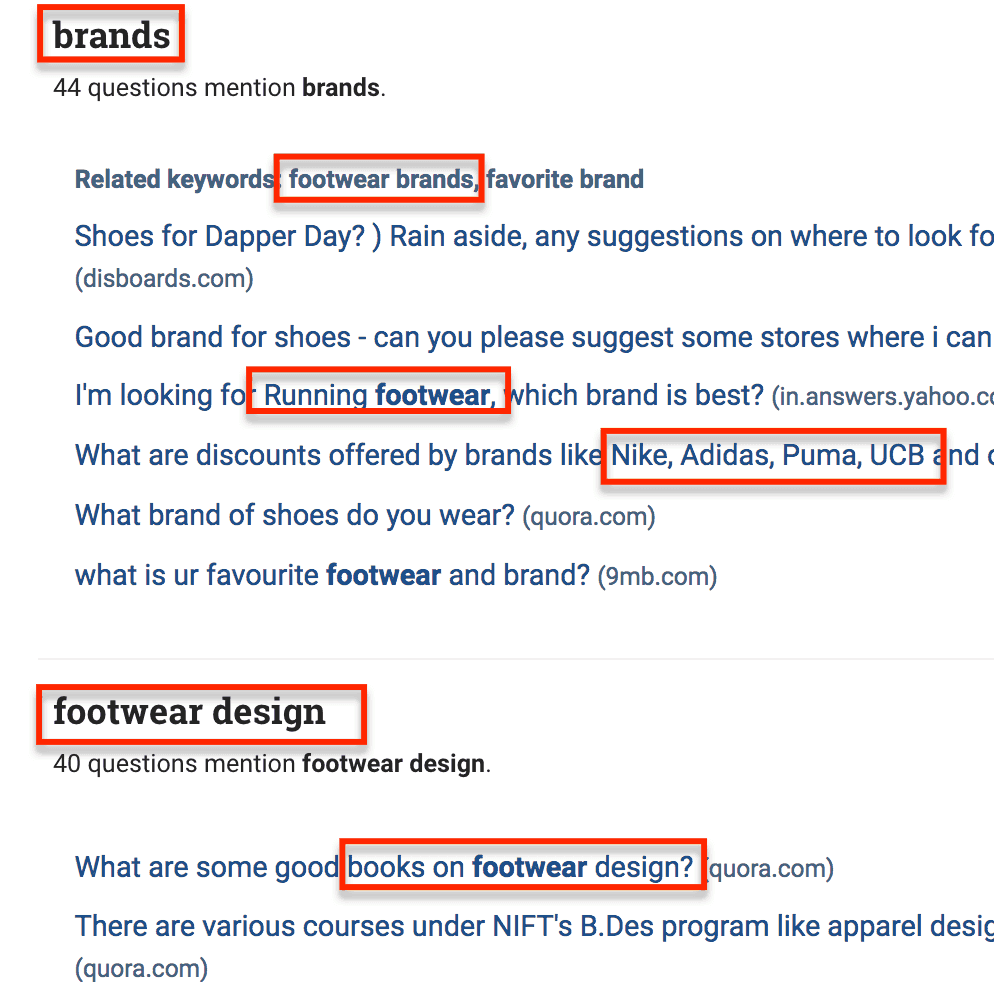
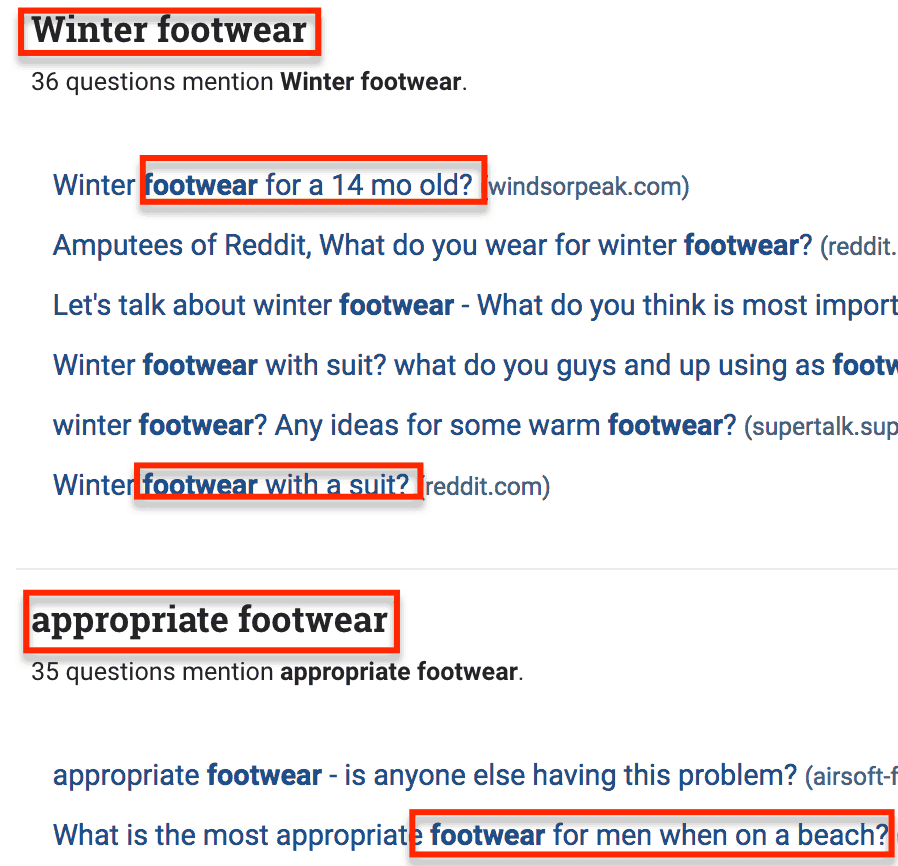
These are great too!
But we’re not done!
2. Find Longtails That Align To Topics
NOW you have to take all … yes, all of your ‘seed topics’ and dig for longtail keywords. You may have dozens or hundreds of seed topics.
There are a few tools I like to find the longtail keywords:
- KeywordTool.io
- Answer The Public
- Or even just looking at Autosuggest terms in Google.
If I do that in KeywordTool.io for ‘winter footwear’ we get lots of ideas:

Note: that you can copy all the keywords, or pay to get search volume right in the tool.
3. Qualify The Topics With ‘Ranking Gaps’
There are two major ranking gaps I’ll show you here:
- Relevance – the current results don’t directly answer the user’s query
- Quality – the current results might match the topic of the query searched, but likely do not satisfy the user
If you find SERPs with either (or both) of these two gaps (and do step #4 perfectly below) – you’ll have a good shot at ranking.
Let me show you some examples.
One longtail term I found from “winter footwear” was “winter home footwear”:

Scan the titles. What do you see?
There is really no piece of content addressing this searcher’s question.
Another one:

Not only does this one have a relevance gap as well – but if you dig in and click on some of the results, you’ll see a big quality gap too.

4. Create Content To Satisfy The User
Who sick of hearing create “great” content??
And then we all try to make it sound better and we say create “quality” content! Create “engaging” content!! “Compelling” content!
With all our platitud-ing about “creating compelling content”, our arguments for that sure aren’t very compelling.
I digress.
When a term like “great” is so vague, there is no actual way to judge how “great” something is. So I like to break “great” down into attributes that actually can be measured – and in aggregate add to up “quality”.
A sample, a few (of many) of these attributes are:
- Length: is the content the right length it needs to be to satisfy the user? Guess what? This is completely different for every topic, niche, query etc. The idea of an ‘optimal’ content length is absurd, and you should throw that idea out. Every post is a clean slate.
- Structure: Should your content be a list, a narrative story, a tutorial?
- Medium: Is it text, images, video – a mix?
- Trust: To what degree do you need to convey trust to the user? Certain fields like medical and finances need a lot of trust conveyed, but others like pop culture need almost no trust conveyed.
- Emotion: Depending on certain topics, content can perform much better if you lead with emotional connection. For example, anything in the self-help, health or productivity space – it helps to form an emotional connection with the reader.
How Do You Figure What Your Content Attribute Mix Should Be?
Just ask Google.
It’s not super hard, but this is the part everyone seems to miss.
Determine your topic/query.
Search it in Google.
Study Google’s SERP in detail.
And also click on every. single. result... to reverse engineer what the user wants.
For example, in our ‘winter home footwear’ SERP – did you notice something?

Google is TELLING you – “Hey! Users want IMAGES”.
So put images in your post.
I want to go a little off course here, and show one more example.
Look at the results ranking here. What format type of content do users want?

A story? Data? Research?
Or… how about a list?
Literally, every result above the fold is some sort of list of ideas. Pretty sure that’s what users are going to want.
Again … if you want to see this process, check out this video I did on YouTube.



